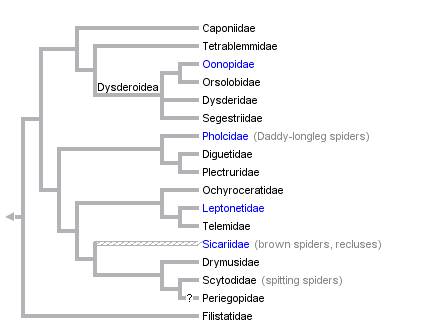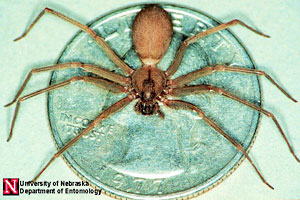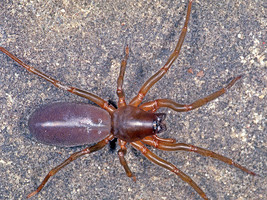Haplogynae



This tree diagram shows the relationships between several groups of organisms.
The root of the current tree connects the organisms featured in this tree to their containing group and the rest of the Tree of Life. The basal branching point in the tree represents the ancestor of the other groups in the tree. This ancestor diversified over time into several descendent subgroups, which are represented as internal nodes and terminal taxa to the right.

You can click on the root to travel down the Tree of Life all the way to the root of all Life, and you can click on the names of descendent subgroups to travel up the Tree of Life all the way to individual species.
For more information on ToL tree formatting, please see Interpreting the Tree or Classification. To learn more about phylogenetic trees, please visit our Phylogenetic Biology pages.
close boxReferences
Coddington, J.A. 2005. Phylogeny and Classification of Spiders. D. Ubick, P. Paquin, P. E. Cushing, and V. Roth (eds.) Spiders of North America: an identification manual, American Arachnological Society. 377 pages. Chapter 2, pp. 18-24.
Coddington, J. A., G. Giribet, M. S. Harvey, L. Prendini, and D. E. Walter. 2004. Arachnida. Pp. 296-318. In Cracraft, J. and M. J. Donoghue (eds.). 2004. Assembling the Tree of Life. Oxford University Press, New York.
Coddington, J. A. and H. W. Levi. 1991. Systematics and evolution of spiders (Araneae). Annual Review of Ecology and Systematics 22:565-592.
Gil, S. G. R., L. M. Mola, A. G. Papeschi, and C. L. Scioscia. 2002. Cytogenetic heterogeneity in common haplogyne spiders from Argentina (Arachnida, Araneae). Journal of Arachnology 30:47-56.
Huber, B. A. 2000. New world pholcid spiders (Araneae : Pholcidae): A revision at generic level. Bulletin of the American Museum of Natural History 254:4-348.
Ramirez, M.J. 2000. Respiratory system morphology and the phylogeny of haplogyne spiders (Araneae, Araneomorphae). Journal of Arachnology 28:149-157.
Platnick, N. I., J. A. Coddington, R. R. Forster, and C. E. Griswold. 1991. Spinneret morphology and the phylogeny of haplogyne spiders. Amer. Mus. Novitates, 3016: 1–73
Title Illustrations

| Scientific Name | Pholcus phalangioides |
|---|---|
| Location | Bear, Delaware, USA |
| Comments | Longbodied Cellar Spider 6mm (Pholcus phalangioides) |
| Reference | http://bugguide.net/node/view/135246 |
| Specimen Condition | Live Specimen |
| Size | 6 mm |
| Image Use |
 This media file is licensed under the Creative Commons Attribution-NonCommercial-NoDerivs License - Version 3.0. This media file is licensed under the Creative Commons Attribution-NonCommercial-NoDerivs License - Version 3.0.
|
| Copyright |
© Ted Kropiewnicki

|
| Scientific Name | Loxosceles reclusa |
|---|---|
| Comments | Brown recluse spider |
| Copyright |
© Jim Kalisch

|
| Scientific Name | Arachnida:Araneae:Dysderidae: Dysdera erythrina |
|---|---|
| Location | “Corno alle Scale” Park, Bologna Province, Emilia Romagna, Italy |
| Specimen Condition | Live Specimen |
| Image Use |
 This media file is licensed under the Creative Commons Attribution-NonCommercial License - Version 2.0. This media file is licensed under the Creative Commons Attribution-NonCommercial License - Version 2.0.
|
| Copyright |
© 2005 Cesare Brizio

|
About This Page
Page copyright © 2006 Jonathan Coddington
All Rights Reserved.
- Content changed 19 August 2008
Citing this page:
Tree of Life Web Project. 2008. Haplogynae. Version 19 August 2008 (temporary). http://tolweb.org/Haplogynae/2650/2008.08.19 in The Tree of Life Web Project, http://tolweb.org/




6mm.200a.jpg)


6mm.100a.jpg)



 Go to quick links
Go to quick search
Go to navigation for this section of the ToL site
Go to detailed links for the ToL site
Go to quick links
Go to quick search
Go to navigation for this section of the ToL site
Go to detailed links for the ToL site